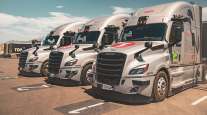Managing Editor, Features and Multimedia
Unmanned Trucks on Public Roads Deemed Far Off by OEMs, Suppliers
This story appears in the July 11 print edition of iTECH, a supplement to Transport Topics.
As autonomous-driving technology continues to advance, one open question is whether this path eventually could lead to fully unmanned trucks traveling down the road.
Even if it becomes possible to completely automate the driving process, it may still be necessary to have a human onboard to handle certain tasks and act as a systems manager and a caretaker for high-value freight.
Manufacturers, suppliers and other experts offered mixed views, but generally argued that driverless trucks would be impractical, or at least many years away for most applications.
“Daimler views the driver as an indispensable part of operating the vehicle,” said Derek Rotz, director of advanced engineering at Daimler Trucks North America. “The autonomous system is designed to support the driver. A driver’s duty goes beyond simply steering, accelerating and braking a vehicle. It includes pre-trip inspections, cargo securement and other responsibilities that are not practical to automate.”
Bill Kahn, principal engineer and manager of advanced concepts at Peterbilt Motors Co., said fully autonomous driving could be possible for yard operations where the truck is in a controlled environment, “but the ability to do that out on the road is still a long ways off.”
CHAT WITH SETH: TT Technology Editor Seth Clevenger takes your questions, noon EDT, July 18
BEST OF JULY iTECH: More stories, columns
Looking further into the future, Kahn predicted that an advanced automated truck would still have a driver in the cab, but that such a truck potentially could lead a convoy of unmanned “drone” trucks.
“That would probably be about as autonomous as you could get,” Kahn said, because cargo thieves could stop in front of an unmanned truck, forcing it to a halt to gain access to the freight.
Fred Andersky, director of customer solutions at Bendix Commercial Vehicle Systems, predicted that vehicle automation will eventually lead to a truly driverless truck, but that it will not be any time soon.
“Getting to the driverless truck is going to be a series of autonomous stepping stones that are going to be built on driver-assistance systems or safety systems,” he said.
However, he also argued that current and prospective drivers should embrace automation rather than fear it.
“For a good long time, it’s going to help them do their job more effectively, efficiently and safely,” he said.
Frank-Detlef Speck, senior manager of advanced engineering for commercial vehicle technology at ZF Friedrichshafen, also said advances in technology could someday enable a truck to run with no driver onboard, but that doesn’t mean the industry will necessarily choose that option.
“From a technical standpoint, the driver won’t be needed when a certain development level is reached, but there may be other tasks that would still make it worthwhile to have the driver in the cab,” he said. “Regarding the timeframe for public roads, full driverless operation is so far in the future that probably no realistic prediction exists.”
However, driverless operation in enclosed or restricted areas would be possible much sooner and could become “quite common in the next decade,” he said.
“Under certain conditions trucks can go autonomously and most probably you could do that without a truck driver, at least once you go in a platoon, but once you go off the highway, for example, you need a driver anyway,” said Joerg Rueger, global president of commercial vehicles at Bosch. “We don’t believe that in the near term we’ll see trucks driverless.”
As driving becomes increasingly automated, the job of the driver will shift from that of a machine operator to a machine supervisor, said Richard Bishop, principal at Bishop Consulting.
“I do believe that automation generally is going to come slowly to the truck and the driver will have a definitive role for a while,” he said.
That phase may continue indefinitely for some operating environments and for some cargo types, such as hazardous materials, but Bishop predicted that it eventually will become possible for a fully autonomous truck to run an entire journey without a human onboard, even in a longhaul application.
In fact, some unmanned mining vehicles are in use today on private property.
Port drayage could be another early application for driverless trucks.
Bishop said he is studying such opportunities for the Florida Department of Transportation. Unmanned truck operation might make sense for drayage trucks making short runs from the ship side to a rail facility on roads that are generally not used by the public, he said.




